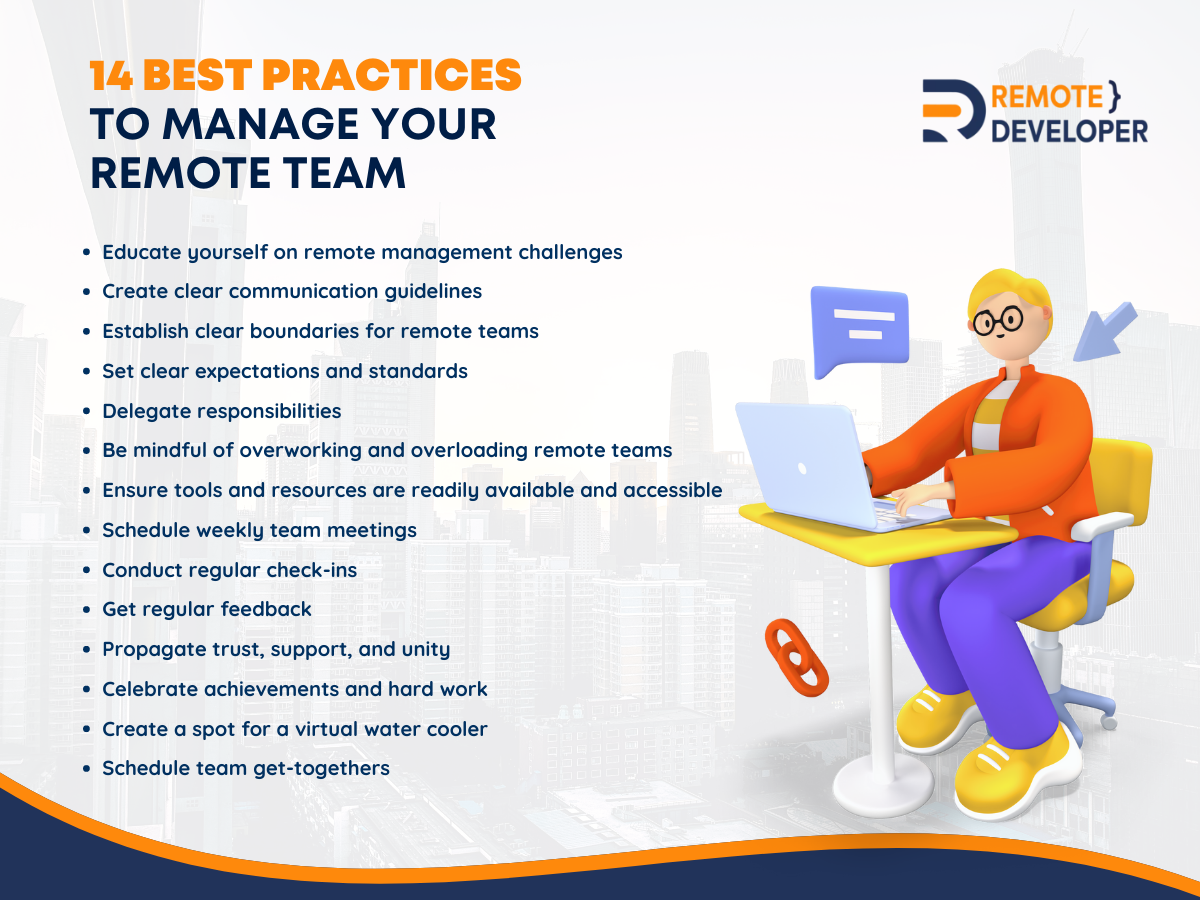A lot of businesses worldwide have realised the perks of remote work at the start of the pandemic. Now, more companies enjoy its benefits and are looking to expand. However, along with these perks, some challenges come with managing a remote team.
The good news is that there are ways to improve managing a remote team. In this article, we put together a comprehensive guide to do just that.
What is a remote team?
Basically, a remote team is a group of skilled working professionals that operate from different locations and time zones. Unlike on-site or hybrid teams, a remote workforce usually works from the comforts of their home or different parts of the world.
This gives various benefits to both the company and the employee. For remote employees, it also enables them to save money and avoid the additional stress that comes with commuting day in and day out.
For the company, a remote workforce helps save business operational costs, such as electricity, internet, equipment, and other office conveniences the company used to provide.
Common challenges in managing a remote team
Despite its popularity around the world, working with a remote team comes with various difficulties. Here are the challenges businesses usually will encounter:
Zero Face-to-Face Supervision
For managers, the prevailing concern is the productivity of each member. In a remote setting, the management team has zero visibility on what their employees do unlike in the traditional office setup where supervisors can monitor each person. Additionally, in some circumstances, an outsourced team needs the physical presence of a supervisor that would motivate them to ensure they meet their deadlines.
Unclear Expectations
In relation to the previous point, an employee might not have the same luxury of immediately knowing and understanding what is expected of them when working remotely.
Low Productivity
Sometimes, remote work does not guarantee the same productivity level as working on-site. While working from home is highly convenient, it should require using productivity tools just to stay on track.
Lack of Communication
In a traditional setup, everyone can freely discuss things and even spontaneously hold meetings. Opposite to this, there are no spontaneous meetings for a remote team. Other than group chats, any in-depth discussion must be intentional and planned beforehand.
Lack of Team Cohesiveness
On-site groups get more benefits compared to remote teams. One thing, in particular, is team cohesiveness. In an office setup where everyone can easily bond. On the other hand, working with an outsourced team, the interaction is solely virtual and is mostly work-focused transactions.
Social Isolation
In the traditional on-site setup, the sense of belonging was taken for granted. Now every member is physically and socially isolated. This makes it hard to get the same sense of being a part of the community compared to before.
Time Difference
Some working outsource teams live on different sides of the world. Operating in different time zones can be challenging since it impacts all forms of communication and collaboration efforts.
Cultural Differences
Every member has a set of beliefs, values, and principles. In addition, they also have varying cultures if they live in different parts of the world. These differences are inevitable. As such, it can be challenging to create good rapport because everything is conducted virtually.
14 Best practices to manage your remote team
Now that you know the common outsourcing mistakes to avoid. Here are the best practices you can do right away and help you effectively manage your remote team.
Educate yourself on remote management challenges
The first step is to identify and understand the challenges a manager and a remote team faces. Some of the common challenges most organisations face are already listed above. However, it is encouraged to personally take stock of every member and interaction to identify specific challenges that need to be resolved.
Create clear communication guidelines
Communication can easily fall by the wayside if there is no deliberate effort from the manager.
With that said, it is suitable for every member to work independently and with minimal supervision. However, this can negatively impact them and make them feel isolated, forgotten, and neglected.
As the manager, it is important to establish clear communication guidelines as early as possible—preferably as part of the onboarding process. These will ensure that communication and information flow is open in a working outsource team.
Establish clear boundaries for remote teams
Furthermore, it is part of the manager’s responsibility to define the boundaries for a remote team.
A lot of people assume setting clear boundaries between work life, and personal life is a private endeavour of an individual. However, supervisors also have an influence in this aspect.
These boundaries can be manifested by clearly stating to the working outsource team when is the best time to message. A manager can also be done by reminding everyone to log out on time and discouraging them to do overtime.

Set clear expectations and standards
Another thing to establish as early as possible, preferably during the job interview and onboarding, are expectations and standards that an employee must follow.
Furthermore, it would be more helpful to be more specific and concrete. Here are a couple of ways to do it:
- Set timeframes or the number of hours employees must render
- Define key performance indicators (KPIs)
- Specify task milestones and deadlines
This is important for every remote worker. But this is eminent for working outsource teams that have a flexible schedule.
Delegate responsibilities
One of the manager’s responsibilities is to delegate the work and tasks to the remote team. Here is how to effectively do it:
- Identify what needs to be done.
- Break down these into tasks.
- Set goals and project milestones to create a clear timeline.
- Identify which member is best suited for each task.
- Share on a project management platform or even a simple excel for easy tracking.
- Brief the details of the project and other essential information to help the team
- Schedule meetings to update on the progress of each task and the overall development of the project
In addition, a manager can also add a reward for finishing a goal within a set timeframe to encourage everyone.
Be mindful of overworking and overloading remote teams
While it is important for a working outsource team to be productive and meet targets, it is important for the manager not to overwork them.
Similar to setting boundaries, as mentioned earlier, a manager’s role is to establish a good working environment (albeit remotely) for everyone. So aside from delegating tasks, it is important to ensure employees are not overloaded or overworked.
With that said, this particular practice can be easily overlooked. In such cases, not only will it affect the well-being of an employee but it can progress to higher turnover rates and lower employee retention.
Ensure tools and resources are readily available and accessible
This practice is essentially standard operating procedure (SOP) already since everyone is working remotely. With that said, we wanted to share this to highlight its importance.
It is essential to ensure that all necessary tools and resources are available and easy to access. This includes making sure new members are already added to weekly meetings, task management tools like Asana and Trello, and file-sharing platforms like Dropbox and Google Drive.
Schedule weekly team meetings
Weekly team meetings ensure a couple of things for both the manager and the remote team:
- It ensures target goals are being met.
- It helps build a bond between teammates.
- It engages everyone to share their thoughts and ideas.
- It opens the opportunity for everyone to bring up any concern and get help.
It is truly a simple email, chat message, or just checking task management tools that can do the same thing. However, weekly meetings humanise the work and make everyone feel involved and part of an actual team.
Conduct regular check-ins
Even though your remote team might not need constant supervision it is important to regularly check in with each member. There are a couple of things that every individual is not comfortable sharing in a group setting and would rather opt to share in a one-on-one setup.
With that said, an employee may indeed request to have a one-on-one chat with a manager. However, this does not occur often unless it is necessary or solely work-related. So it is up to the manager to hold regular check-ins.
Get regular feedback
There is always room for improvement, especially when managing a remote team. Having a one-on-one chat with every member allows a manager to identify which parts or processes can be tweaked and enhanced.
Another option is to create a survey and give them a level of anonymity. This enables employees to share honest feedback without fear of any repercussions.
Propagate trust, support, and unity
Working remotely can feel isolating if there is no interaction between teammates. Furthermore, isolation has a negative mental and psychological effect on the well-being of your remote team.
So, avoid these and help build trust is to take a proactive approach to check in with each member:
- Ask questions about how they are doing and empathise with them. This can be at the start or the end of a meeting.
- Create a support network. Remind teammates that you and the rest of the team are here to help or lend an ear to listen to any problems they might have.
Celebrate achievements and hard work
The simple act of acknowledging the effort of a team member is enough to have a positive impact on morale and the whole team.
The act of appreciation and gratitude encourages a positive work relationship and inspires other members to also step up and do better. In addition, giving rewards will incentivise everyone as well.
Create a spot for a virtual water cooler
A virtual water cooler is exactly what it sounds like: a relaxed place where teammates can interact and chat. This can be a dedicated chat or it can be just at the start or at the end of a team meeting. The point is to create sincere and spontaneous interactions among teammates and bonding.
Schedule team get-togethers
With that said, the best way is to meet physically. This can be a simple lunch to spend time together and chat outside of work. It can also be events where teams can work together and socialise, like team-building events, seminars, and even parties.
Final Thoughts
Managing a remote team can be challenging because it has a few handicaps. However, thanks to new tech innovations, there are more ways to circumvent these handicaps and help you effectively manage a remote team.
Still, businesses should pay attention to the human aspect of managing a remote team. While tools can help resolve specific distance-related issues, the quality of the interactions and a team’s unity can help your remote team thrive and meet your goals.
Do you need to scale your in-house staff with a remote team? Visit our website and learn more about how Remote Developer can help you!

